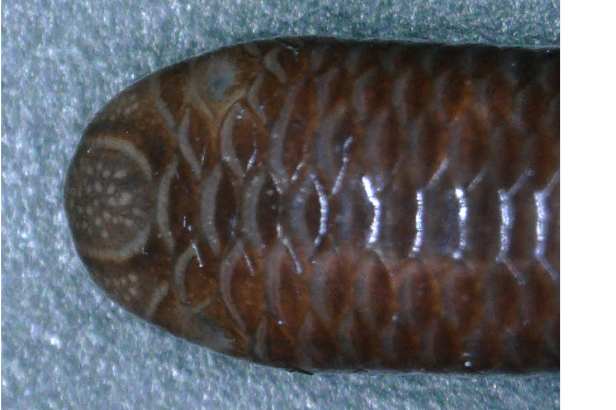Gerrhopilus floweri


head from above (© MCZ Harvard) 
Bangkok (CAS 101599 photo – Erica Ely) 
Head (CAS 101599 photo – Erica Ely) 
Tail (CAS 101599 photo – Erica Ely)
MCZ Harvard photos courtesy of Museum of Comparative Zoology, Harvard University. Photo credit to Joe Martinez.
English name: Flower’s Blind Snake
Scientific name: Gerrhopilus floweri (formerly Typhlops floweri)
Thai name: งูดินหัวเหลือง (Ngu-din Hua Leuang)
Description: To 23cm long. Head is relatively flat and wide for a blind snake. Tail is blunt and lacks the sharp tail spine found in many local blind snakes. Coloration is blackish-brown above and pale brown below with cream color from snout to chin and around anal region (note that above photos are preserved specimens and colors may have faded somewhat in preservation).
Relevant scale counts: There are 18 rows of scales at the middle of the body. Glands scattered around head scales rather than falling along particular suture lines.
Similar Species: Roxane’s Blind Snake has a stouter body, head glands falling along lines, and 20 midbody scale rows.
Brahminy Blind Snake has a sharp tail tip, head glands falling along lines, and 20 midbody scale rows.
White-headed Blind Snake has a white head with glands falling along lines, a sharp tail tip and 20 midbody scale rows.
Slender Worm Snake is more slender, has head glands falling along lines, and a sharp tail tip.
Diard’s Blind Snake is far bulkier, had head glands falling along lines, and has 24-30 midbody scale rows .
Blind snake species are difficult to distinguish from each other, so if you need specific identifying markers you should use this key to the blind snakes in Thailand.
Range: Central Thailand.
Habitat: Naturally found in evergreen forests, but also shows up in parks and gardens. Spends most of the time underground. Likely travels on the surface on rainy or humid nights.
Place in the ecosystem: This snake helps control insect and other arthropod populations by feeding on their larvae and pupae. It is eaten by larger fossorial snakes and other animals.
Danger to humans: Blind snakes are harmless – they have no venom and their mouths are too small to bite a human. When uncovered or picked up they tend to respond by wiggling vigorously and emitting a small amount of smelly musk.
Conservation status and threats: This species is almost never seen due to its secretive nature. Without any meaningful monitoring, it is difficult to know whether such a rarely seen species is on the verge of extinction or doing just fine.
Interesting facts: Flower’s Blind Snake is endemic to Thailand, which means that it has never been found anywhere else. It is only known from a small area of the country, with records from Bangkok, Ayutthaya Province, and Khao Soi National Park.
Though blind snakes share a similar general appearance, some of them actually differ quite a bit genetically. Most of Thailand’s blind snakes belong to the family Typhlopidae, or “Typical Blind Snakes”. Flower’s Blind Snake is the one exception, hailing from the family Gerrhopilida, known as “Indo-Malayan Blind Snakes”. You may notice that it appears to have a different body and tail shape than the other local species, and if you look closely at the head you can see that its glands are “peppered” all over the scales rather than falling on distinct lines.
References:
Typhlops roxaneae, a new species of Thai blindsnake from the T. diardii species group, with a synopsis of the Typhlopidae of Thailand
A Key to the Blind Snakes of Thailand
A Field Guide to the Reptiles of South-East Asia